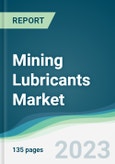The mining lubricants market is estimated to grow at a CAGR of 5.02% during the forecast period.
Lubricants such as oils, greases, and fluids are utilized in the mining sector to diminish friction and prevent wear between the mobile components of mining machinery. These lubricants play a critical role in maintaining the health and longevity of mining machinery exposed to extreme temperatures, heavy loads, and harsh environments. The mining industry relies heavily on large, heavy-duty equipment such as drills, loaders, bulldozers, excavators, and hauls trucks. These machines operate under tough conditions and require continuous lubrication to prevent metal-to-metal contact, reduce friction, and dissipate heat. Mining lubricants are formulated to withstand the extreme pressures, temperatures, and contamination that mining machinery is exposed to, ensuring optimal performance and longevity.Mining lubricants are available in various formulations, each designed to meet the specific needs of different mining applications. For example, some mining lubricants are designed to operate at high temperatures, while others are formulated to resist water and other contaminants. Some mining lubricants are also biodegradable, making them ideal for environmentally sensitive mining operations.
Mining lubricants market growth drivers:
- Increasing demand for mineral and metal commodities-The demand for minerals and metals is projected to increase, particularly in emerging economies such as China and India, as they continue to develop their infrastructure and expand their manufacturing sectors. The increase in mining activities is expected to drive the demand for heavy-duty mining equipment, which requires high-performance lubricants to ensure optimal performance and longevity.
- Growing adoption of automation and advanced mining technologies-Mining companies are increasingly adopting automation and advanced technologies to increase efficiency and reduce costs. For example, autonomous vehicles can operate 24/7 without breaks or fatigue, reducing downtime and improving productivity. However, these advanced technologies require high-performance lubricants to ensure optimal performance and longevity. The increasing adoption of these technologies is expected to drive the demand for specialized lubricants that can withstand extreme temperatures and heavy loads, ensuring the reliability and longevity of equipment.
Market Developments:
- In February 2021,Shell revealed its plans to provide carbon-neutral lubricants to its customers for various products such as passenger cars, heavy-duty diesel engines, and industrial applications, including mining.
- In August 2022,Chevron Lubricants launched a new product, Delo TorqForce Syn FD-1, a synthetic lubricant designed for the axles and final drives of large mining haul trucks and other auxiliary equipment. It is formulated to enhance performance over traditional SAE 60 TO-4 and FD-1 products and provide maximum system protection. It provides a broad temperature range for all-weather performance throughout the year, exceptional cold-weather flowability, and excellent oxidation resistance at high temperatures for longer oil life. Moreover, Delo TorqForce Syn FD-1 features innovative additives that minimize wear in heavily loaded gears and bearings, keep metallic components free of varnish and sludge, and enhance protection against rust, corrosion, and wear, thereby maximizing the equipment's service life in severe conditions.
- In March 2023,Petro-Canada Lubricants launched PRODURO TO-4+ UHP, a new synthetic all-season fluid, to improve the performance of heavy-duty mining and construction equipment. The fluid enhances system temperature, increases equipment durability, and safely extends oil drain intervals. The company claims it can help mining operators save on operating costs and support sustainability goals by prolonging equipment life. The lubricant is expected to reduce equipment wear while providing reliable protection and optimal performance.
The mineral oil segment is expected to witness robust growth.
The mining lubricants market based on mineral oil products is expected to experience steady growth during the projected period. Mineral oil-based lubricants are widely used in the mining industry due to their excellent lubrication properties and cost-effectiveness. They are primarily used in applications such as gearboxes, hydraulic systems, and compressors. In addition to their excellent lubrication properties, mineral oil-based lubricants are also preferred due to their high compatibility with several tools and ability to perform well under extreme temperature and pressure conditions.North America accounted for a significant share of the global mining lubricants market.
Based on geography, the mining lubricants market is segmented into North America, South America, Europe, the Middle East and Africa, and Asia Pacific. The mining lubricants market in North America is expected to grow steadily during the projected period. The US is one of the region's largest consumers of mining lubricants, owing to its significant mining industry. The country has abundant reserves of natural resources, such as coal, copper, gold, and silver, primarily extracted through mining activities. The demand for mining lubricants in the US is driven by the need to enhance the lifespan of mining equipment and reduce maintenance costs. According to the U.S. Geological Survey, in 2021, mines in the United States produced mineral commodities worth around $90.4 billion, which marks a $9.7 billion increase from the revised total of $80.7 billion in 2020.Market Segmentation:
By PRODUCT TYPE
- Mineral Oil
- Synthetic Mining
- Bio-based Mining
By APPLICATION
- Bauxite Mining
- Iron ore Mining
- Coal Mining
- Precious Metals Mining
- Rare Earth Mineral Mining
- Others
By GEOGRAPHY
- North America
- USA
- Canada
- Mexico
- South America
- Brazil
- Argentina
- Others
- Europe
- Germany
- France
- United Kingdom
- Spain
- Others
- Middle East And Africa
- Saudi Arabia
- UAE
- Israel
- Others
- Asia Pacific
- China
- India
- South Korea
- Indonesia
- Thailand
- Taiwan
- Others
Table of Contents
Companies Mentioned
- Lubrication Engineers
- Shell Global
- Total Energies
- Exxon Mobil Corporation
- Telko Ltd.
- Gulf Oil Lubricants India Ltd.
- Castrol Ltd.
- LUKOIL lubricants company
- Chevron Corporation
- Sinopec








